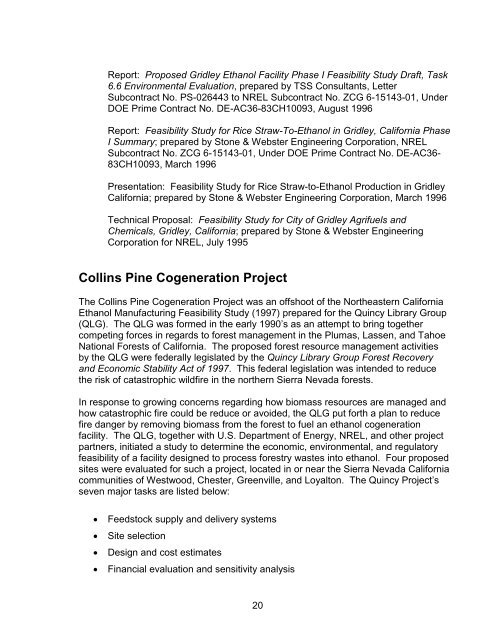Assessment of Conversion Technologies for Bioalcohol Fuel ...
Assessment of Conversion Technologies for Bioalcohol Fuel ...
Assessment of Conversion Technologies for Bioalcohol Fuel ...
You also want an ePaper? Increase the reach of your titles
YUMPU automatically turns print PDFs into web optimized ePapers that Google loves.
Report: Proposed Gridley Ethanol Facility Phase I Feasibility Study Draft, Task<br />
6.6 Environmental Evaluation, prepared by TSS Consultants, Letter<br />
Subcontract No. PS-026443 to NREL Subcontract No. ZCG 6-15143-01, Under<br />
DOE Prime Contract No. DE-AC36-83CH10093, August 1996<br />
Report: Feasibility Study <strong>for</strong> Rice Straw-To-Ethanol in Gridley, Cali<strong>for</strong>nia Phase<br />
I Summary; prepared by Stone & Webster Engineering Corporation, NREL<br />
Subcontract No. ZCG 6-15143-01, Under DOE Prime Contract No. DE-AC36-<br />
83CH10093, March 1996<br />
Presentation: Feasibility Study <strong>for</strong> Rice Straw-to-Ethanol Production in Gridley<br />
Cali<strong>for</strong>nia; prepared by Stone & Webster Engineering Corporation, March 1996<br />
Technical Proposal: Feasibility Study <strong>for</strong> City <strong>of</strong> Gridley Agrifuels and<br />
Chemicals, Gridley, Cali<strong>for</strong>nia; prepared by Stone & Webster Engineering<br />
Corporation <strong>for</strong> NREL, July 1995<br />
Collins Pine Cogeneration Project<br />
The Collins Pine Cogeneration Project was an <strong>of</strong>fshoot <strong>of</strong> the Northeastern Cali<strong>for</strong>nia<br />
Ethanol Manufacturing Feasibility Study (1997) prepared <strong>for</strong> the Quincy Library Group<br />
(QLG). The QLG was <strong>for</strong>med in the early 1990’s as an atempt to bring together<br />
competing <strong>for</strong>ces in regards to <strong>for</strong>est management in the Plumas, Lassen, and Tahoe<br />
National Forests <strong>of</strong> Cali<strong>for</strong>nia. The proposed <strong>for</strong>est resource management activities<br />
by the QLG were federally legislated by the Quincy Library Group Forest Recovery<br />
and Economic Stability Act <strong>of</strong> 1997. This federal legislation was intended to reduce<br />
the risk <strong>of</strong> catastrophic wildfire in the northern Sierra Nevada <strong>for</strong>ests.<br />
In response to growing concerns regarding how biomass resources are managed and<br />
how catastrophic fire could be reduce or avoided, the QLG put <strong>for</strong>th a plan to reduce<br />
fire danger by removing biomass from the <strong>for</strong>est to fuel an ethanol cogeneration<br />
facility. The QLG, together with U.S. Department <strong>of</strong> Energy, NREL, and other project<br />
partners, initiated a study to determine the economic, environmental, and regulatory<br />
feasibility <strong>of</strong> a facility designed to process <strong>for</strong>estry wastes into ethanol. Four proposed<br />
sites were evaluated <strong>for</strong> such a project, located in or near the Sierra Nevada Cali<strong>for</strong>nia<br />
communities <strong>of</strong> Westwood, Chester, Greenvile, and Loyalton. The Quincy Project’s<br />
seven major tasks are listed below:<br />
Feedstock supply and delivery systems<br />
Site selection<br />
Design and cost estimates<br />
Financial evaluation and sensitivity analysis<br />
20
















